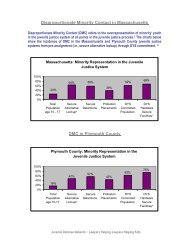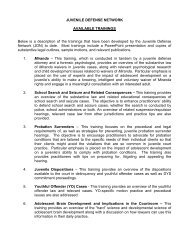Adolescent Brain Development - the Youth Advocacy Division
Adolescent Brain Development - the Youth Advocacy Division
Adolescent Brain Development - the Youth Advocacy Division
Create successful ePaper yourself
Turn your PDF publications into a flip-book with our unique Google optimized e-Paper software.
<strong>Adolescent</strong> <strong>Brain</strong> <strong>Development</strong><br />
Quick Reference Fact Sheet<br />
Background<br />
• With <strong>the</strong> recent cases of Graham v. Florida (2010), Roper v. Simmons (2005), Atkins v. Virginia (2002), and<br />
Thompson v. Oklahoma (1988), <strong>the</strong> topics of adolescent brain development and juvenile culpability have come to<br />
<strong>the</strong> forefront of juvenile criminal law. In Graham, <strong>the</strong> Supreme Court declared it unconstitutional to sentence<br />
juveniles convicted of non-homicide offenses to life without <strong>the</strong> possibility of parole. In Thompson and Roper, <strong>the</strong><br />
Supreme Court declared it unconstitutional to give <strong>the</strong> death penalty to juveniles (Thompson set <strong>the</strong> age limit to<br />
16, Roper to 18). In each of <strong>the</strong>se cases, <strong>the</strong> underlying rationale was that juvenile offenders tend to lack maturity<br />
(both socially and biologically), are more reckless, are more susceptible to peer pressure, and are more vulnerable<br />
to <strong>the</strong>ir surroundings than adults. In both Graham and Atkins, <strong>the</strong> topic of brain development played a crucial role<br />
in <strong>the</strong> Court determining that <strong>the</strong> sentence in question was not appropriate in light of <strong>the</strong> lessened culpability of<br />
<strong>the</strong> category of offenders challenging <strong>the</strong> sentence (juveniles in Graham, mentally retarded individuals in Atkins).<br />
Indeed, <strong>the</strong> Graham decision went as far as stating that “An offender’s age is relevant to <strong>the</strong> 8 th amendment, and<br />
criminal procedure laws that fail to take defendants’ youthfulness into account at all would be flawed.” Graham v.<br />
Florida, No. 08-7412, slip. op at 25, 560 U.S. __ (2010)<br />
• <strong>Adolescent</strong> brain development has become an increasingly accurate field of research in recent years due to <strong>the</strong><br />
development of magnetic resonance imaging (MRI) procedures. Prior to <strong>the</strong> use of MRI technology, <strong>the</strong> only<br />
major studies that had been performed involved post-mortem (cadaver) tissue, since X-rays and o<strong>the</strong>r means of<br />
testing were deemed potentially harmful to youth. MRI technology allows for <strong>the</strong> same subject to be tracked from<br />
infancy into adulthood. 1<br />
• States and <strong>the</strong> federal government generally do not recognize youth as being mature enough to handle many<br />
situations. For example, youth cannot drive until age 16 (varies by state, w/ most adopting restrictions on under 18<br />
drivers), or see rated R movies without adult supervision until <strong>the</strong>y are 17. They cannot vote, smoke, sign<br />
contracts, enter military services, or get married (varies by state) until age 18. And lastly, <strong>the</strong>y cannot drink until<br />
age 21. The implications of <strong>the</strong>se social norms indicates that society does not fully trust youth with many<br />
privileges, and thus do not consider <strong>the</strong>m as responsible as adults. 2<br />
Implications<br />
• As compared to adults, juveniles have a “‘lack of maturity and an underdeveloped sense of responsibility’”; <strong>the</strong>y<br />
“are more vulnerable or susceptible to negative influences and outside pressures, including peer pressure”; and<br />
<strong>the</strong>ir characters are “not as well formed.” 3<br />
• “The evidence is strong that <strong>the</strong> brain does not cease to mature until <strong>the</strong> early 20s in those relevant parts that<br />
govern impulsivity, judgment, planning for <strong>the</strong> future, foresight of consequences, and o<strong>the</strong>r characteristics that<br />
make people morally culpable.” 4<br />
• “Neuroscientists have been able to demonstrate conclusively that mental maturation follows closely <strong>the</strong> time<br />
course of brain maturation. Thus, juveniles have to rely on <strong>the</strong> abilities of <strong>the</strong>ir still immature brains, and no<br />
amount of social intervention or self-motivation can appreciably influence <strong>the</strong> biological processes involved in<br />
brain maturation.” 5<br />
• “The cortical regions that are last to mature… are involved in behavioral facets germane to many aspects of<br />
criminal culpability. Perhaps most relevant is <strong>the</strong> involvement of <strong>the</strong>se brain regions in <strong>the</strong> control of aggression<br />
and o<strong>the</strong>r impulses, <strong>the</strong> process of planning for long-range goals, organization of sequential behavior,<br />
consideration of alternatives and consequences, <strong>the</strong> process of abstraction and mental flexibility, and aspects of<br />
memory including ‘working memory.’… If <strong>the</strong> neural substrates of <strong>the</strong>se behaviors have not reached maturity<br />
before adulthood, it is unreasonable to expect <strong>the</strong> behaviors <strong>the</strong>mselves to reflect mature thought processes.”<br />
[Emphasis Added]. 6

















